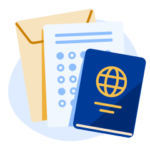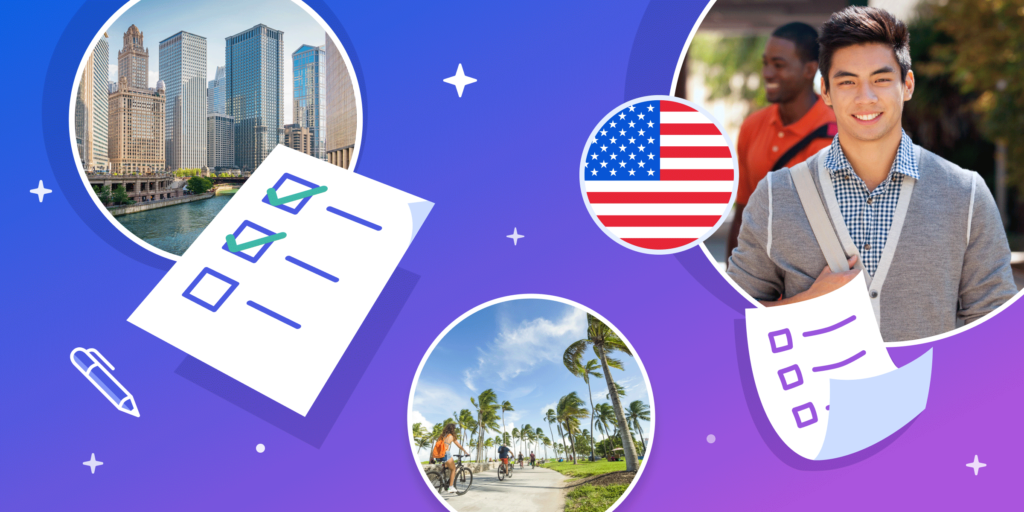Are you considering studying in the United States as an international undergraduate student? If so, you could be joining the largest international student population in the world. In 2024, over a million international students travelled to the US for their studies.
In this post, we’ll explore major steps in the American undergraduate application process. (Curious about postgraduate study in the US? Check out our companion blog!) Before you start to apply, check your target programs’ pages on the ApplyBoard platform for current information.
Looking at multiple destinations? We’ve got undergraduate application guides for Canada, the United Kingdom, and Australia.

Get Started Early
Consider starting your research as early as 24 months before you’d like to start your program. This also gives you time to complete any prerequisite classes for your program, if needed. Plus, some documents may need to be mailed physically.
Although entrance qualifications vary by program, you’ll need to meet or exceed a specific score on an English language proficiency test if you’re from a country where English isn’t an official language.
Did You Know? Forgetting to include your English proficiency test score in your application has serious consequences. If it’s not included, your application may be denied.
The most recognized tests in the US are the Test of English as a Foreign Language (TOEFL) and the International English Language Testing System (IELTS). Check with your target colleges or universities if other proficiency tests like the Pearson Test of English (PTE) or the Duolingo English Test are accepted.
Most undergraduate student applicants need a minimum score of:
- IELTS: between 6.0 and 7.5, with no band less than 6.0
- TOEFL (internet-based test, iBT): between 60.0 and 105.0 overall
Should you go with TOEFL or IELTS? Find out on our blog!

Build Your Application
With 12 to 13 months to go, start assembling your applications. Once you’ve decided which programs you’re applying to, check individual program pages for specific requirements.
These are some common documents you may have to include in your program application:








Application Timelines and Options
Specific application deadlines vary by program. Most students in the US start classes in September, which is widely considered the official start of the school year. Some programs may also begin in January or May. Programs in higher demand often have shorter application windows, while other program applications will stay open until the program is full.
US academic institutions offer students one of the following options when they apply:
- Regular Decision (RD): Ideal for students unsure of where they want to apply. RD lets students take more time to complete their application or retake their ACTs or SATs. Most students submitting their application through RD do so in January.
- Early Action (EA): Useful for students who are unsure about attending a particular institution. Students may apply to multiple institutions through early action. Application deadlines are often in early November.
- Early Decision (ED): Best for students that know exactly where they would like to study. The application for ED is a binding contract, so it can be difficult to cancel if the student changes their mind. ED application deadlines are in early November.
- Rolling Admission (RA): A good option for students that apply to one institution through EA, then decide they want to attend a different one. This option is also available if students finish their applications early. RA deadlines are flexible, so students may submit their applications starting in the fall and into the spring of their intake year.
Figuring out your study abroad budget? These eight questions can help you stay balanced.

School Responses and Student Visa Information
With four or five months to go, you should hear back from the institutions you applied to. Now, work independently or with a recruitment partner to make your program selection, accept and return the best offer, and pay your tuition deposit.
When applying for admission to the US, international students must complete a Form I-20, which will be sent to you after accepting an offer of admission from that institution’s international student office. The I-20 certifies your eligibility for nonimmigrant student status.
Once the I-20 is complete, you must pay the I-901 SEVIS fee and apply online for a nonimmigrant student visa (F-1 or M-1) using Form DS-160. As part of the application, you may also need to schedule a visa interview.
Once you’ve got your student visa, start setting up your life as an international student. Research housing, health insurance, and travel arrangements. Don’t forget there’s lots to find off-campus, too.
A month before classes start, send your arrival details to any parties who require it. Before you know it, you’ll be an international student in the US. Best of luck!
Ready to apply for your US F-1 visa? Learn more about the interview process on our blog.



